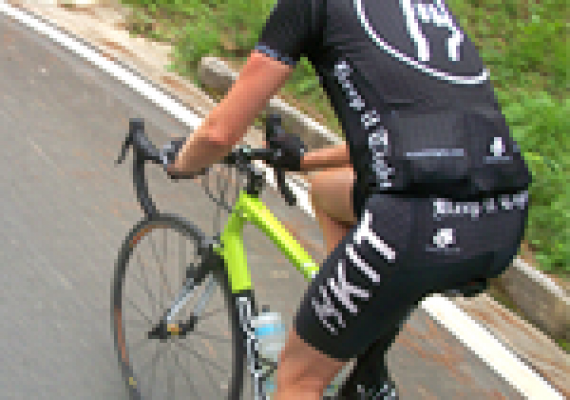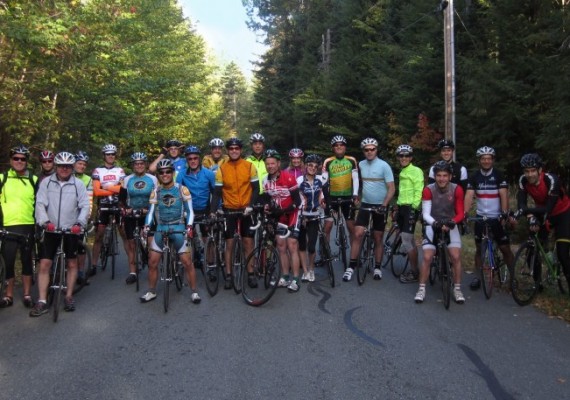By guest KIT blogger, Cort Cramer
 In your quest to KEEP IT TIGHT during this time of year, often refered to as the “off-season,” it is important to recognize that what you do this winter can have a significant impact on your performance during the next racing season. Regardless of whether you ride outdoors year-round or confined to indoor training for a solid five months, if you’re looking forward to a successful upcoming season the preparation needs to start NOW.
In your quest to KEEP IT TIGHT during this time of year, often refered to as the “off-season,” it is important to recognize that what you do this winter can have a significant impact on your performance during the next racing season. Regardless of whether you ride outdoors year-round or confined to indoor training for a solid five months, if you’re looking forward to a successful upcoming season the preparation needs to start NOW.
Before you embark on your official winter training programme, it is important to make sure you are well-rested and recovered from the previous season or year’s worth of training. A few weeks completely off followed by one to two weeks of easy cross-training are essential to recharging your physical and mental batteries. Doing so can prepare you for the work that lies ahead. Once you are rested, recharged, and ready to go the following key elements should be incorporated into your winter programme to ensure you start the next season firing on all cylinders:
CROSS TRAINING SESSIONS
Variety is the spice of life. Many dedicated athletes swear off any type of cross training in the winter, instead opting to approach their Decembers like their Julys: sport-specific training, and little else. Runners, swimmers and cyclists alike often end up with postural abnormalities, muscle imbalances, and strength discrepancies as a result of the repetitive movements involved in their respective disciplines.
Weight training may be the critical link for many athletes to have that extra edge in enhancing athletic performance once racing season rolls around. There are many reasons for incorporating weight training and core work into your winter programme. Such benefits include but are not limited to boosting your metabolism, helping regulate hormonal balance, improving posture, and most importantly, playing a major part in finding the necessary power at the end of a fatiguing event. If you’re unsure where to start, any knowledgeable coach or fitness professional can guide you in setting up a winter strength programme. The programme should include the appropriate set/rep/rest and weight schemes that will give you the stability, strength and power gains to boost your performance and take your fitness to that next level. In a similar vein, Pilates or yoga classes can have a phenomenal effect on core and stability, helping you to transfer energy from your upper to lower body while helping to strengthen and protect your lower back. Try a class or two per week and you’ll immediately see why these types of activities are beneficial to your fitness.
If you’re the type that enjoys playing in the snow, then take your winter cross training outdoors and enjoy it! Mountain biking, hiking, trail running, and nordic skiing are just a few types of outdoors activities which can elicit season-appropriate amounts of cardiovascular system stimulus. Keep it fun and not too intense as cross-training, in theory, should enhance your cycling (or similar primary endurance discipline) and not cause major cardiovascular stress or, even worse, injury. If the cross training activity is new-to-you, take it easy those first few sessions and break yourself in slowly!
REST AND RECOVERY
A second component of a successful winter programme is rest! Many endurance athletes, though fully mindful that too much training in the winter will make them a “Christmas Star” continue to do so year-in and year-out. There is no doubt that training hard in the Winter is beneficial, but the frequency at which you do so is often the difference between pushing yourself to the next level for the coming year and peaking in January. One key element to increasing your “Functional Threshold Power (FTP)”, is to only train intensely for two days in a row before incorporating at least one day of rest or active recovery. Every other week, give yourself two days of easy training after two hard days to keep your battery charged. In addition to balancing your work-to-rest ratio, be mindful of the amount of sleep you’re getting. Winter is a great time to take advantage of your decreased training volume and give your body and mind the rest and repair needed. Balance your hard training with proper rest, enter 2012 fresh and strong, and you’ll win much more than just those January rides!
A properly executed winter training regimen will elevate your FTP to that next level, maintain your ability to change cadences and ensure you arrive at the start of the 2012 racing season with a fresh body and rejuvenated mind prepared for the season ahead. Keep your focus this winter and make 2012 your breakthrough season!
Stay tuned for Part 2…
*Cort Cramer, M.S. is USA Cycling Level 2 certified and Associate Coach at Peaks Coaching Group.



Sorry, the comment form is closed at this time.